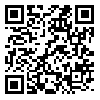Volume 15, Issue 1 (Spring 2007)
JSSU 2007, 15(1): 9-13 |
Back to browse issues page
Download citation:
BibTeX | RIS | EndNote | Medlars | ProCite | Reference Manager | RefWorks
Send citation to:



BibTeX | RIS | EndNote | Medlars | ProCite | Reference Manager | RefWorks
Send citation to:
Aarafi H, Islami Z, Noori Shadkam M, Manoocheri-Naeini M, Jalalpour S, Abyari S. Comparison of the Effectiveness of Oral Sucrose and Emla Cream in Reduction of Acute Pain Due to Heel Sticks for Blood Sampling in Neonates. JSSU 2007; 15 (1) :9-13
URL: http://jssu.ssu.ac.ir/article-1-670-en.html
URL: http://jssu.ssu.ac.ir/article-1-670-en.html
Abstract: (12747 Views)
Introduction: Certain painful, invasive procedures are necessary for care, and are commonly performed in both healthly and sick neonates. Current evidence shows that the newborn infant has both physiologic and anatomic capacity to experience pain. Recent research suggests that pain experienced in the neonatal period might have long-term effects later in life. Previous research has shown that orally administered sweet-tasting solutions reduce signs of pain during painful procedures. This effect is considered to be mediated both by the release of endorphins and by a preabsorptive mechanism related to the sweet taste.
Methods: This study was a controlled , randomized and double – blind study on 210 neonates. These newborns were randomly divided into 3 groups A, B and C. Group A received 2 ml of 25% sucrose orally as well as base cream was applied at the site for heel stick, group B received 2 ml of distilled water and application of EMLA cream, while group C received 2 ml of distilled water and base cream. The heart rates of the newborn were recorded by the cardiac monitor before and after heel stick blood sampling and the duration of crying was determined as well. Pain was scored by DAN scale.There were no differences in demographic characteristics of all neonates.
Results: The results showed that the DAN scale was significantly lower in the sucrose group (mean : 3.840) as compared to the EMLA group (mean: 3.366) and the placebo group(5.557), but the difference in the duration of crying was not significantly different in the sucrose group (mean: 10.5 second) and the EMLA group(mean 8.76).
Conclusion: Both sucrose and EMLA are effective in reducing stress associated with heel lancet in newborns, but as sucrose acts faster and is healthier, its usage is proposed in neonates requiring heel sticks for blood sampling.
Send email to the article author
| Rights and permissions | |
 |
This work is licensed under a Creative Commons Attribution-NonCommercial 4.0 International License. |





